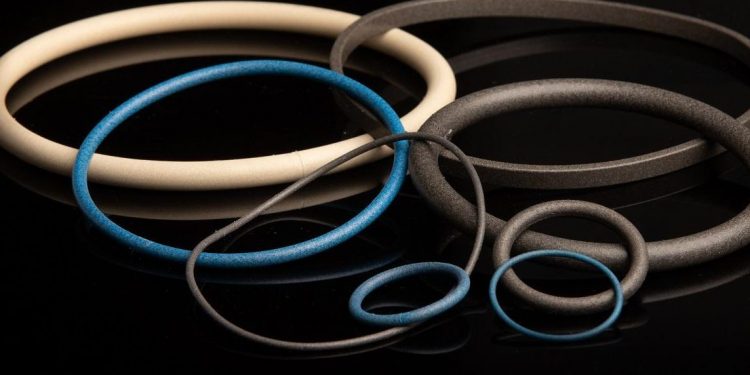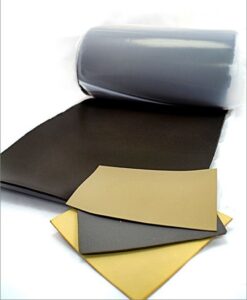SSP fabricates conductive EMI O-rings from the EMI silicones that we fabricate. Learn about material selection, fabrication methods, and EMI O ring applications.
Conductive EMI O-rings are electrically-conductive gaskets that provide reliable shielding against electromagnetic interference (EMI), disturbances that can disrupt electronic components, modules and systems. These EMI shielding gaskets are made of specialty silicones that are packed with metallic or metal-coated particles. Silicones, a family of synthetic elastomers, withstand a wide range of temperatures and provide environmental sealing. The metallic or metal-coated particles in EMI silicones conduct electricity.
EMI O-rings are not the same as flat EMI washer gaskets. They’re also different than jam nut seals, D-subminiature gaskets and other EMI gaskets used for sealing and shielding. At the most basic level, EMI O-rings are toroidal or donut-shaped EMI extrusions. This supports their usage in demanding applications where temperature, pressure, and tolerances could cause other types of elastomeric gaskets (such as flat washers) to fail. Still, there’s plenty to consider about EMI O-ring selection and fabrication.
Conductive EMI O-Ring Selections
EMI O-rings seal electronic enclosures and ensure electrical conductivity. They require compression and must maintain contact with mating surfaces. Because these conductive gaskets are subject to compressive forces that are both periodic and extended, EMI O-rings must withstand compression set – the permanent deformation of a material when a force is removed. If an EMI O-ring fails to “bounce back” when this force is removed, sealing and shielding failure could occur after the force is applied again.
Selecting an EMI silicone with the right durometer is especially important then. Durometer, a measure of hardness, is measured on the Shore A scale. Shielding silicones with lower durometers are softer and more compressible. Shielded gaskets with higher durometers are harder and provide greater impact resistance. EMI gasket designers also need to determine which filler material provides the right balance between cost and performance, and whether a fluorosilicone base material is needed because of chemical exposure.
EMI O-Ring Fabrication: Cutting and Bonding
Conductive EMI O-rings can be compression molded, but they’re also cut from extruded cords and then bonded into finished products. Manual cutting can be used, but processes like die cutting and water jet cutting provide greater precision and reduced cycle times – especially over larger quantities. To join the ends of cords that have been cut-to-size, gasket fabricators can use either cold splicing or vulcanizing. Each joining method has its advantages and disadvantages.
Cold splicing applies a non-conductive adhesive to the cord ends. No heat is required, but a cord that’s been spliced incorrectly may permit the passage of unwanted electromagnetic frequencies. For EMI O-rings that are made of fluorosilicones, cold splicing is challenging because of fluorosilicone rubber’s greater chemical resistance. Vulcanized EMI O-rings take longer to produce and have higher tooling costs but are made from a single electrically-conductive material for more reliable conductivity and shielding.
EMI O Ring Applications
EMI O ring applications include electronic enclosures, military and aerospace hardware, telecommunications equipment, automotive electronics, medical devices, and industrial control systems.
- Electronics Enclosures: Used in cases for sensitive electronics (like medical devices, military gear, aerospace avionics, and communications equipment) to prevent EMI from entering or leaking out.
- Military & Aerospace Hardware: Radar systems, satellite systems, aircraft control panels, and other mission-critical hardware often use EMI O-rings to meet strict shielding and sealing standards.
- Telecommunications Equipment: In server racks, cell tower base stations, and data center enclosures to block interference between densely packed systems.
- Automotive Electronics: Modern vehicles are equipped with many onboard electronics (ECUs, sensors, infotainment, radar, lidar, etc.). EMI O-rings help avoid crosstalk and meet electromagnetic compatibility (EMC) requirements.
- Medical Devices: Equipment like MRI machines, patient monitoring systems, and diagnostic electronics use EMI O-rings to maintain clear signal integrity and patient safety.
- Industrial Control Systems: Machinery with programmable logic controllers (PLCs) or robotics that operate in high EMI environments use these to keep systems stable.
Where to Source EMI O-Rings
Specialty Silicone Products (SSP) provides a full line of EMI extrusions, including solid round cord for EMI O-rings, in various durometers. To learn more, contact SSP on-line.





